Intangible cultural heritage of Georgia
Intangible cultural heritage (Georgian: არამატერიალური კულტურული მემკვიდრეობა) are elements of the cultural heritage of Georgia which are abstract and must be learned, encompassing traditional knowledge including festivals, music, performances, celebrations, handicrafts, and oral traditions.
Starting from 2011, 37 items were inscribed on the registry of Georgia's Intangible Cultural Heritage as of August 2017. Three of them have been placed on the UNESCO Intangible Cultural Heritage Lists.[1][2]
Registry of Intangible Cultural Heritage of Georgia
| # | Item | Date inscribed | Comment | Media |
|---|---|---|---|---|
| 1 | Georgian polyphonic singing | 17 November 2011 | Inscribed in 2008 on UNESCO's Representative List of the Intangible Cultural Heritage of Humanity (originally proclaimed in 2001).[3] |
|
| 2 | Kvevri | 17 November 2011 | Large egg-shaped earthenware vessels used for the fermentation, storage, and ageing of traditional Georgian wine. |  |
| 3 | Traditional kvevri wine-making method | 27 March 2012 | Inscribed in 2013 on UNESCO's Representative List of the Intangible Cultural Heritage of Humanity.[4] | 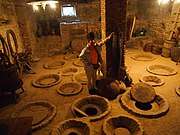 |
| 4 | Dedaena, an introduction to Georgian for children | 25 March 2013 | Dedaena, literally, "a mother tongue", a children's primer compiled and published in 1876 by Iakob Gogebashvili |  |
| 5 | Traditional dance Perkhuli | 25 March 2013 | A predominantly male folk round dance, with as many as 20 versions. |  |
| 6 | Berikaoba | 25 March 2013 | An improvised masqueraded folk theatre, stemming from a pre-Christian festivity of fertility and rebirth. |  |
| 7 | Kakhetian Mravalzhamieri | 25 March 2013 | A polyphonic folk song Mravalzhamieri ("polychronion") from the region of Kakheti. | |
| 8 | "Urban" Mravalzhamieri | 25 March 2013 | An urban version of Mravalzhamieri from Tbilisi. | |
| 9 | Children's literary magazine Dila | 25 November 2013 | A popular children's literary magazine founded in 1928 as Oktombreli and renamed in 1947 as Dila ("The Morning").[5] | |
| 10 | Traditional dance Khorumi | 25 November 2013 | A traditional war dance, originally from the region of Adjara. | 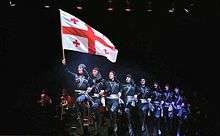 |
| 11 | Meskhetian cheese Tenili | 25 November 2013 | Originally from the region of Meskheti, Tenili is made of threads of rich cow's or sheep's milk cheese briefly brined before being pressed into a clay pot.[6] | 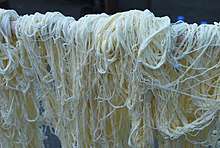 |
| 12 | "Makeup Anointment", an annual Shota Rustaveli Theatre and Film University students induction ceremony | 5 January 2014 | An annual induction ceremony of the Tbilisi-based Shota Rustaveli Theatre and Film University freshmen held at Marjanishvili Memorial Museum in Kvareli, a tradition established in 1974.[7][8] | |
| 13 | Literary magazine Tsiskari | 5 January 2014 | The Georgian-language literary magazine Tsiskari ("The Dawn"), founded in 1852. |  |
| 14 | Technology and culture of the Lagidze Waters | 5 January 2014 | The Lagidze Waters are a popular brand of soft drinks established by Mitropane Lagidze in 1887.[9] | 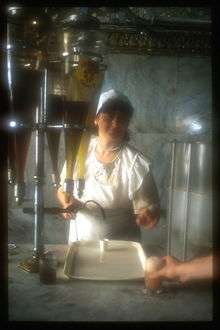 |
| 15 | Chidaoba, a Georgian wrestling style | 25 September 2014 | A Georgian folk wrestling style. | 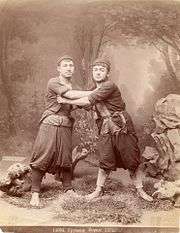 |
| 16 | Dambalkhacho | 25 September 2014 | A variety of moistened curd from the highland province of Pshavi.[10] | 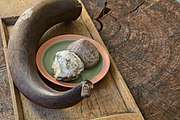 |
| 17 | "Living culture of three writing systems of the Georgian alphabet" | 20 March 2015 | Inscribed in 2016 on UNESCO's Representative List of the Intangible Cultural Heritage of Humanity.[11] |  |
| 18 | Chuniri | 20 March 2015 | A bowed folk musical instrument from the region of Svaneti. | 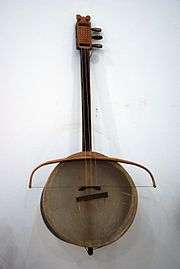 |
| 19 | Svan hat | 20 March 2015 | Traditional technology of felted wool hat making from Svaneti, one of important elements of the Svan cultural identity. |  |
| 20 | Svan cuisine: P'etvraal | 20 March 2015 | A Svanetian variety of khachapuri, a traditional Georgian dish of cheese-filled bread, but with added millet flour to its cheese filling. | |
| 21 | Svan cuisine: Kubdari (Kubed) | 20 March 2015 | A meat filled pastry, a signature dish of Svaneti.[12] |  |
| 22 | Svan cuisine: Svanuri Marili or Lushnu Jim | 20 March 2015 | Svanetian salt, a traditional spicy salt blend. | |
| 23 | Svan cuisine: Tashmjab | 20 March 2015 | A cream of potatoes and cheese mixed with corn flour from Svaneti. | |
| 24 | Tradition of learning Vepkhistqaosani by heart | 7 October 2015 | The tradition of learning and reciting the 12th-century national epic Vepkhistqaosani ("The Knight in the Panther's Skin") by Shota Rustaveli, composed of some 1,500 stanzas, was widespread among the Georgians, especially young women,[13][14] and survived into the 21st century.[15] | 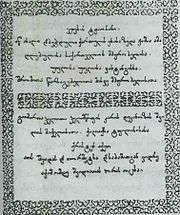 |
| 25 | Tradition of use of medicinal mineral springs in Upper Svaneti | 15 October 2015 | The mineral springs of Mugviri, Artskheeli, Kakhrld, Legab, Seti, Kvedilash, and Shdegi have been used for medicinal purposes for several centuries. | |
| 26 | Traditional technique of making the Svanetian folk instrument Changi | 15 October 2015 | Changi is a Svanetian version of an ancient harp-like instrument with at least six strings.[16] |  |
| 27 | Tradition of wood carving in Svanetian architecture and household items | 15 October 2015 | Pieces of vernacular architecture and churches in highland Svaneti are richly adorned with ornate wood carving, a tradition going back to the Middle Ages.[17] |  |
| 28 | Literary magazine Gantiadi | 15 October 2015 | Gantiadi ("The Daybreak"), a Georgian literary magazine established in Kutaisi in 1915. | |
| 29 | Technology of Kakhetian Churchkhela | 7 November 2015 | Churchkhela made in Georgia's wine-making region of Kakheti is a particularly popular variety of this traditional Georgian candle-shaped candy, strings of nuts that are repeatedly dipped in concentrated grape juice. | 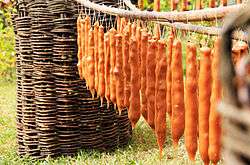 |
| 30 | Kakhetian hat | 7 November 2015 | A felted hat from the region of Kakheti. |  |
| 31 | Kakhetian bread "dedas puri" | 7 November 2015 | Dedas puri ("mother's bread") is a Kakhetian type of tonis puri, baked in a specific bakery. |  |
| 32 | Tradition of pottery in Vardisubani | 7 November 2015 | The village of Vardisubani is the principal center of traditional pottery in Kakheti. | |
| 33 | Svan funeral ritual with zari | 16 March 2016 | Zari (zär) is a funeral chant from Svaneti, bearing traces of pre-Christian tradition.[18][19] | |
| 34 | Tradition of falconry | 27 October 2016 | Old Georgian tradition of falconry, bazieroba. | .jpg) |
| 35 | Supra, a traditional Georgian feast | 29 March 2017 | Supra, a traditional Georgian feast and an important part of Georgian social culture. | 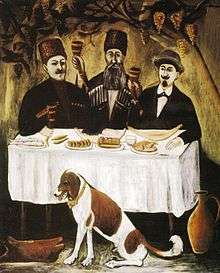 |
| 36 | Traditional culture and manufacturing technology of blue tablecloth | 9 June 2017 | Traditional Georgian cotton tablecloths painted in various shades of blue, known from at least the 17th century.[20][21] | 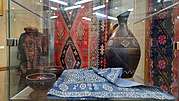 |
| 37 | Georgian folk medicine | 23 August 2017 | Georgian folk medicine and traditions associated with its use | |
| 38 | Twenty-six-century-long tradition of the Georgian–Jewish relations | 13 April 2018 | The Jewish presence in Georgia is regarded to have began with their exodus during the Babylonian captivity in 6th century BC. |  |
| 39 | Tskhavati pottery | 13 April 2018 | Tradition of pottery from the village of Tskhavati. | |
| 40 | Georgian silk | 12 June 2018 |
References
- ↑ "არამატერიალური კულტურული მემკვიდრეობა" [Intangible Cultural Heritage] (PDF) (in Georgian). National Agency for Cultural Heritage Preservation of Georgia. Retrieved 25 October 2017.
- ↑ "UNESCO Culture for development indicators for Georgia (Analytical and Technical Report)" (PDF). EU-Eastern Partnership Culture & Creativity Programme. October 2017. pp. 82–88. Retrieved 25 October 2017.
- ↑ "Intangible Heritage: Georgian polyphonic singing". The United Nations Educational, Scientific and Cultural Organization. Retrieved 22 October 2017.
- ↑ "Intangible Heritage: Ancient Georgian traditional Qvevri wine-making method". The United Nations Educational, Scientific and Cultural Organization. Retrieved 22 October 2017.
- ↑ "დილა" [Dila]. Iverieli Digital Library (in Georgian). National Parliamentary Library of Georgia. Retrieved 22 October 2017.
- ↑ Goldstein, Darra (2013). The Georgian Feast: The Vibrant Culture and Savory Food of the Republic of Georgia. University of California Press. p. xvi. ISBN 9780520275911.
- ↑ "ყოველწლიურ სტუდენტურ ტრადიციას მიენიჭა არამატერიალური კულტურული მემკვიდრეობის ძეგლის სტატუსი" [An annual student tradition granted the status of an Intangible Cultural Heritage element.] (in Georgian). NNLE Heritage For Future. 18 February 2014. Retrieved 22 October 2017.
- ↑ "Majanishvili House-Museum Hosted the Freshmen Oath Ceremony". The Financial. 2 November 2009. Retrieved 22 October 2017.
- ↑ ",,ლაღიძის წყლების დამზადების ტექნოლოგია და კულტურა"" [Technology and culture of the Lagidze Waters.] (in Georgian). NNLE Heritage For Future. 18 February 2014. Retrieved 22 October 2017.
- ↑ "Dambalkhacho - Georgian delicacy with the status of cultural heritage". Georgian Journal. 17 October 2014. Retrieved 22 October 2017.
- ↑ "Intangible Heritage: Living culture of three writing systems of the Georgian alphabet". United Nations Educational, Scientific and Cultural Organization. Retrieved 22 October 2017.
- ↑ "Kubdari – A Signature Dish of Svaneti". Georgian Journal. 9 October 2017. Retrieved 22 October 2017.
- ↑ Wardrop, Marjory Scott (2001). The Man in the Panther's Skin: A Romantic Epic Translated from the Georgian by Marjory Wardrop. Psychology Press. p. 265. ISBN 9780947593438.
- ↑ Lang, David Marshall (1966), Landmarks in Georgian Literature: An Inaugural Lecture Delivered on 2 November 1965 (PDF), London: School of Oriental and African Studies, University of London, p. 22, retrieved 22 October 2017
- ↑ Rekhviashvili, Jimsher (9 October 2015). ""ვეფხისტყაოსანი" ზეპირად" [Vepkhistqaosani by heart]. Radio Free Europe/Radio Liberty (in Georgian). Retrieved 22 October 2017.
- ↑ "Changi". Georgian Folk Music Instruments. Retrieved 23 October 2017.
- ↑ Sumbadze, Longinoz (1967). "ჩუქურთმა ხეზე ხალხურ ხუროთმოძღვრებაში" [Ornate carving in vernacular architecture]. Dzeglis megobari (in Georgian). 12: 54–65.
- ↑ Kalandadze-Makharadze, Nino (2006). "The Funeral Zari in Traditional Male Polyphony". In Tsurtsumia, Rusudan; Jordania, Joseph. The Second International Symposium on Traditional Polyphony (PDF). Tbilisi: International Research Center for Traditional Polyphony of Tbilisi State Conservatoire. pp. 166–178.
- ↑ Zemp, Hugo (2007). Funeral chants from the Georgian Caucasus: Study Guide (PDF). Documentary Educational Resources. pp. 2–16.
- ↑ "Blue tablecloths: Restored tradition and regained popularity". Agenda.ge. 12 August 2015. Retrieved 24 October 2017.
- ↑ Meparishvili, Nana (11 August 2015). "The Blue Tablecloths of Georgia: New Life of an Old Tradition". Folklife. Smithsonian Center for Folklife and Cultural Heritage. Retrieved 24 October 2017.
This article is issued from
Wikipedia.
The text is licensed under Creative Commons - Attribution - Sharealike.
Additional terms may apply for the media files.